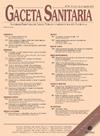巴斯克地区按性别、年龄和社会经济水平划分的久坐和缺乏身体活动。调查
IF 1.5
4区 医学
Q3 HEALTH CARE SCIENCES & SERVICES
引用次数: 0
摘要
目的描述巴斯克地区不同性别、年龄和社会经济水平的久坐和缺乏身体活动的患病率。方法基于2018年巴斯克自治区健康调查(n = 7814名成年人)进行横断面研究。计算了总体上和按年龄组的久坐和缺乏身体活动的粗略患病率,并通过稳健的泊松回归模型评估了社会经济模式的存在。结果久坐不动的总体患病率在性别中约为32%,在85岁以上年龄组中达到60%,在18 - 29岁的年轻人中达到45%。缺乏身体活动的患病率在男性中为22%(最年轻的15%,最年长的37%),在女性中为29.5%(最年轻的17%,最年长的64%)。久坐不动和缺乏运动的流行程度因社会经济水平而异,社会地位越高的人越久坐,而受教育程度越低的人越不爱运动。结论在本研究的背景下,根据社会经济水平和生命周期的不同,身体活动和久坐生活方式存在不同的模式。本文章由计算机程序翻译,如有差异,请以英文原文为准。
Sedentarismo e inactividad física según sexo, edad y nivel socioeconómico en el País Vasco. Estudio transversal
Objective
To describe the prevalence of sedentarism and physical inactivity according to sex, age, and socioeconomic level in the Basque Country.
Method
A cross-sectional study was conducted based on the 2018 Basque Autonomous Community Health Survey (n = 7814 adults). Crude prevalences of sedentarism and physical inactivity, overall and by age group, were calculated, as well as the existence of a socioeconomic pattern was assessed through robust Poisson regression models.
Results
The overall prevalence of sedentarism was around 32% in sexes, reaching 60% in the age group older than 85 years and 45% in young people aged 18 to 29 years. The prevalence of physical inactivity was 22% in men (15% in the youngest and 37% in the oldest) and 29.5% in women (17% in the youngest and 64% in the oldest). Differences were found in the prevalences of sedentarism and physical inactivity according to socioeconomic level, with people of higher social class being more sedentary, and people with lower educational level being more inactive.
Conclusions
In the context of the study, there is a different pattern in terms of physical activity and sedentary lifestyle according to socioeconomic level and life cycle.
求助全文
通过发布文献求助,成功后即可免费获取论文全文。
去求助
来源期刊

Gaceta Sanitaria
医学-公共卫生、环境卫生与职业卫生
CiteScore
4.10
自引率
5.30%
发文量
80
审稿时长
29 days
期刊介绍:
Gaceta Sanitaria (Health Gazette) is an international journal that accepts articles in Spanish and in English. It is the official scientific journal of the Sociedad Española de Salud Publica y Administración Sanitaria (Spanish Society of Public Health and Health Administration) (SESPAS).
The Journal publishes 6 issues per year on different areas of Public Health and Health Administration, including:
-Applied epidemiology-
Health prevention and promotion-
Environmental health-
International health-
Management and assessment of policies and services-
Health technology assessments-
Health economics.
The editorial process is regulated by a peer review system. It publishes original works, reviews, opinion articles, field and methodology notes, protocols, letters to the editor, editorials, and debates.
 求助内容:
求助内容: 应助结果提醒方式:
应助结果提醒方式:


